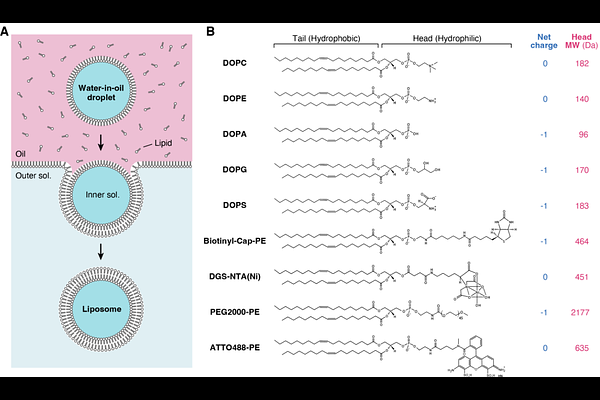Lipid composition effects on the number and size of liposomes formed by the inverted emulsion method

Lipid composition effects on the number and size of liposomes formed by the inverted emulsion method
Sakata, H.; Matsubara, H.; Gomi, K.; Miyazaki, M.
AbstractLiposomes have been widely employed as membrane scaffolds in the construction of minimal cell models. In 2002, the inverted emulsion method was introduced as a novel technique for generating giant liposomes by transferring water-in-oil droplets across an oil/water interface. This technique enables the encapsulation of purified proteins or cytoplasmic extracts into cell-sized liposomes under physiological buffer conditions, and has since become a cornerstone in bottom-up synthetic biology. Despite its broad application over the past two decades, the effects of lipid composition on the production yield and size distribution of liposomes generated by the inverted emulsion method remain largely unknown. In this study, we systematically investigated the effects of phospholipid composition on the production yield and size distribution of liposomes generated using the inverted emulsion method. We used a natural phosphatidylcholine purified from chicken egg yolk (egg PC) as the base membrane component, and examined the extent to which substituting a fraction of egg PC with other phospholipids, differing in net electric charge and/or the molecular weight of their hydrophilic head groups, affects the number and size distribution of liposomes. We found that a 10% replacement of egg PC with charged phospholipids significantly enhances the production yield of liposomes by approximately tenfold, transformed by both the natural gravitational force and the greater force applied by centrifugation. In addition, lipids with smaller head groups slightly enhance the production yield in both methods. Lipids with larger head groups also slightly enhance the production yield and promote the formation of larger liposomes in the natural sedimentation method, but these effects are diminished in the centrifugal sedimentation method, presumably due to the strong centrifugal force. These findings provide valuable guidelines for optimizing preparation protocols for minimal cell models.